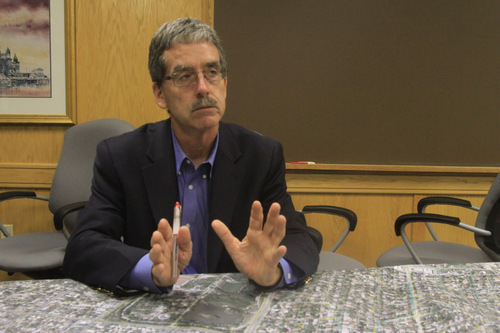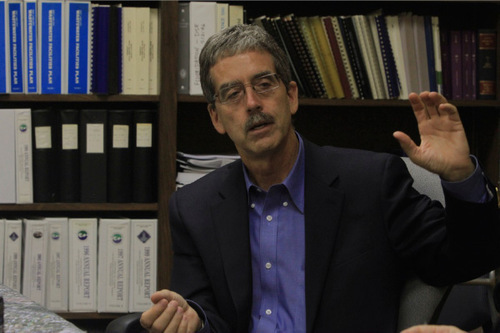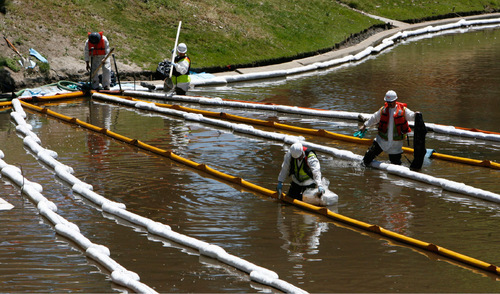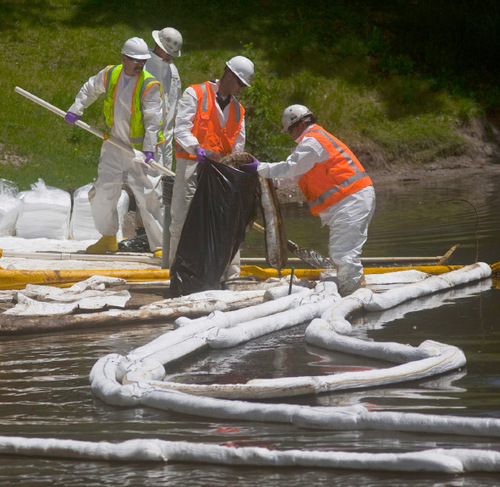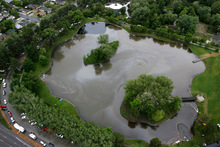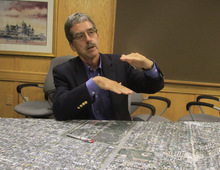This is an archived article that was published on sltrib.com in 2010, and information in the article may be outdated. It is provided only for personal research purposes and may not be reprinted.
Salt Lake City public utilities boss Jeff Niermeyer was at home getting ready for a Saturday morning bike ride when a phone call alerted him to an emergency near the University of Utah.
Crude oil was bubbling up at Red Butte Garden, streaming down a creek through an east-side neighborhood, flowing across Liberty Park's pond and oozing into the Jordan River.
Niermeyer, unaware at the time of the scope of the unfolding disaster, rushed to a staging area, brainstormed with colleagues and made a swift but simple decision — one that would prove crucial in containing Salt Lake City's first major oil spill.
He had crews plug a culvert with sandbags so the park's pond could capture the oil and prevent any more from funneling farther west.
That quick thinking essentially turned the pond into a catch basin for most of the 33,600 gallons of oil that leaked from a ruptured Chevron pipeline near the botanical garden. It also prevented the crude from saturating the stream bank near hundreds of west-side homes and stopped it from fouling the Great Salt Lake wetlands that serve millions of migratory birds.
Niermeyer insists the decision was no act of genius — only the logical conclusion reached by professionals trained in crisis response.
"Anticipating what's coming at you," he said, "is a big part of emergency planning."
As the three-month mark since the Red Butte spill approaches this weekend, Niermeyer and others are looking back as they seek guidance on the restoration that still lies ahead.
Robin Carbaugh, the city's ombudsman for affected residents, said advisory groups are devising restoration plans with an emphasis on health effects, the environment, economic impact and how to prevent future spills.
To many, the handling thus far of the Chevron pipeline spill has mostly been a success. Hundreds of scarred birds (primarily at Liberty Park) were treated (about a half dozen died) and scores of residents were driven from their homes by the fumes. About half the 100 individual claims have been paid.
Crews have recovered about 610 barrels of the 800 spilled, according to company estimates. Another 100 barrels evaporated.
As of early September, workers near Red Butte Garden were excavating oil-contaminated soil. Crews were tackling trouble spots along Red Butte Creek, and efforts at Liberty Park were expected to continue through October.
An investigation by the Office of Pipeline Safety continues. But the federal agency already has indicated that a power arc from a nearby transformer punched a dime-size hole in the pipe — which carries oil from Colorado to a refinery in north Salt Lake City — and has allowed Chevron to resume using the repaired line.
Meanwhile, the Utah Division of Water Quality, which slapped the company with a notice of violation for the spill in July, continues to work with the oil giant on plans to restore and monitor affected areas.
Reflecting on the response and cleanup to date, division Director Walt Baker said, "there weren't any huge missteps."
Baker's agency, along with Niermeyer's, the U.S. Environmental Protection Agency, the city's fire department and nearly a dozen other organizations all became part of an emergency command system that responders nationwide have been perfecting for decades, most recently after 2005's Hurricane Katrina and the Sept. 11, 2001, terrorist attacks.
The plan basically puts first responders in charge of addressing the immediate emergency — in Red Butte's case, the city's fire department — then transitions to a unified command comprising federal, state and local agencies.
Niermeyer noted Salt Lake City has been practicing for community-scale emergencies since before the 2002 Winter Olympics. Those drills helped prepare the capital for the June 11-12 oil spill, the state's largest in at least four years, and an unusual occurrence for a major Utah city.
"Through the training we've had as a city," Niermeyer said, "[we've learned] you can't necessarily make these unilateral decisions [such as pooling the oil in the pond] without at least helping each other understand. Even though it may take more time, a group decision is better."
One of the most difficult moments, he recalled, came that first afternoon, when Chevron — with its decades of oil-spill experience — asked to take charge of the Red Butte response.
"I had to be willing," Niermeyer said, "to put my ego aside."
Hired by the city 19 years ago to write a storm-water report for the EPA, the public utilities director boasts an encyclopedic command of the labyrinth of pipes, streams, springs, culverts, drains and irrigation gates buried under the city.
"He's intimate with where every molecule of water in the city goes," said city spill czar Renee Zollinger, who credits Niermeyer's deft decision with helping to avert a greater crisis downstream and in the Great Salt Lake.
"I can't even imagine," Zollinger said, "what it would have been like to clean up those wetlands."
10 biggest recent oil spills in Utah
Excluding June's 800-barrel Red Butte Creek spill, here are Utah's biggest spills since 2006 — showing the amount, county, date and company.
300 barrels • Duchesne County, Feb. 21, 2007, El Paso E&P Co.
290 barrels • Duchesne County, April 11, 2007, Newfield Production Co.
250 barrels • Duchesne County, Sept. 11, 2008, Newfield Production Co.
250 barrels • Uintah County, Dec. 1, 2008, Newfield Production Co.
240 barrels • Duchesne County, Oct. 4, 2008, Berry Petroleum Co.
240 barrels • Duchesne County, May 20, 2007, Petroglyph Operating Co.
210 barrels • Duchesne County, Dec. 2, 2008, El Paso E&P Co.
196 barrels • Duchesne County, Oct. 3, 2007, FIML Natural Resources, LLC.
180 barrels • Duchesne County, Oct. 14, 2008, Berry Petroleum Co.
166 barrels • Uintah County, Jan. 21, 2006, QEP Uinta Basin Inc.
Source: Utah Department of Natural Resources —
Search for spills
To search a database of oil and gas incidents in Utah back to 2006, go to http://extras.sltrib.com/oil_and_gas


